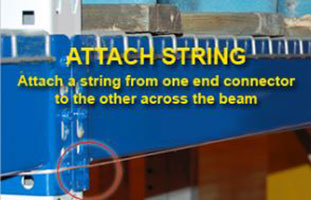Does it matter how I place pallets on the rack?
Manufacturer’s beam tables are generally based on uniformly distributed loads. Both the capacity and the beam deflection will vary if the load is not uniformly distributed on the load shelf beams. A short list of things that can cause non-uniform loading are:
1.) Feet or runners on the load that cause point loading on the beam.
2.) Loads that have non-uniform weight or mass over their projected area.
3.) Loads that are not symmetrically placed on the shelf either in depth or width.
4.) Loads that are undersized for the shelf. (These loads can be placed towards the center of the beam rather than towards the rack frame. This will aggravate the stress and deflection of the beam.)
How are beams sized by the rack designer?
Beams are checked for strength (stress) and deflection (serviceability) and the limit that is reached first will govern the rating of the beam. Beams that are deep relative to their span will reach their stress limit first and are referred to as “stress governed”. Beams with a longer span that are shallow relative to their span will reach their deflection limit first and are referred to as “deflection governed”. The RMI deflection limit for a normal pair of pallet rack beams is L/180 or the span divided by 180. A 96” beam will have a deflection limit of 96/180 = 0.533”.
Why is the RMI Deflection limit L/180?
This deflection limit is an aesthetic limit that was set forth many years ago. It is based on what was judged to be the normal visual comfort level for deflection. Excessive deflection will and should cause unease for those in and around the rack. It is worth noting that some believe they should see no deflection and are alarmed when they witness any deflection. To require beams that exhibit only very slight deflection would be very expensive and require beams that are very deep relative to their spans.
Are there some cases where L/180 deflection is too much?
Yes. Often times where automatic equipment is involved a much tighter deflection limit is specified for the load beams. Also, catwalk beams that support walking aisles should be designed for less deflection (L/240 is often used).
How do I properly measure the deflection of a pallet rack shelf beam?
The easiest way to get a fairly accurate deflection is to stretch a string across the bay that is some distance below the beam (usually just below the connectors). The string is taught and is adjusted up and down at the ends so that the distance from the bottom of the beam and the string is the same at both ends. Mark the centerline of the beam. Symmetrically place the loads (weighed loads) on the beam in both the front and back direction and the side-to-side direction. The loads should be uniform in weight so the front and the rear beams are equally loaded. Measure the distance from the bottom of the beam to the string at mid-bay and subtract this from the distance from the bottom of the beam to the string at the ends. This is your beam deflection. Bear in mind that there is measurement error here as in any other procedure.
The reason to use the string in this manner is that it removes error that may result if you just measure from the floor with a tape measure. Doing this may cause error if the floor is not level. Another reason for using this method is that any downward displacement of the connection is also eliminated from the deflection. The deflection test is to determine only the actual bow in the beam cause by the loading. There are also more high-tech ways of checking deflection with lasers, etc.
What should my deflection be if my applied load is less than the rating of the beams?
The deflection should be relative to the deflection capacity of the beam if the load is less. For example, if a 96” shelf with a stress capacity is 5000# per pair and a deflection capacity of 5500# per pair, is uniformly loaded with 3000# per shelf, the anticipated deflection at 3000# would be: (3000/5500) x 0.533” = 0.291”.
Would added yield strength reduce deflection?
No. Deflection is not a function of yield strength. Added yield strength may increase the stress capacity of the beam but not the deflection capacity.
Would added steel thickness reduce deflection?
Yes. Added steel thickness will increase the stiffness of the beam and reduce deflection. A more economical way to reduce deflection is added section depth because a beam section’s ability to resist deflection is an exponential function of its depth and only a linear function of its thickness.
